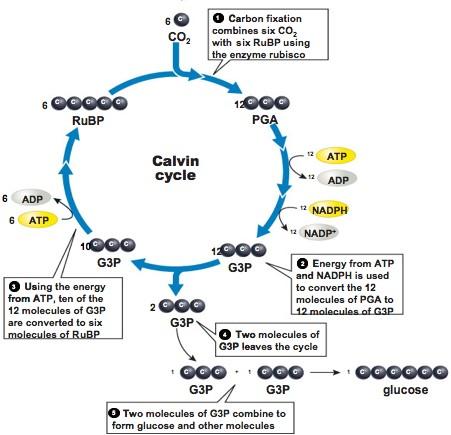The dark reaction, also called the Calvin cycle as that is the actual mechanism of this reaction, is the second and final phase of photosynthesis. The final products of this stage are sugar molecules, which can be in the form of glucose or combined to create starch.
It is important to mention before getting too far into this discussion, that this process is called the dark reaction because it is light-independent. The name the “dark reaction” does not mean that this process happens at night. It actually happens at the same time as the light reaction. At night, the light reaction is unable to make the reactants required for this cycle so this process actually cannot occur during the night.
This reaction requires ATP and NADPH from the light reactions and CO2 from the atmosphere. The Calvin cycle occurs in the stroma of the chloroplast and is basically a series of reactions which result in the production of carbohydrates. The first reaction in this cycle is referred to as carbon fixation.
CO2 is needed to react with a starting material called RuBP, which is a 5 carbon molecule. This reaction is catalyzed by the enzyme Rubisco (RuBP Carboxylase/Oxygenase), which has a high affinity for carbon. It is important to note that Rubisco is actually capable of combining with both carbon and oxygen, but it is carbon that we want it to react with in this cycle.
This 6 carbon molecule is then almost instantaneously split into two three carbon molecules called 3-phosphoglycerate. The 6 carbon molecule created just before this is unstable and thus, splits. The products of the light reaction, NADPH and ATP are used to carry these two molecules through a series of reactions and produce two molecules of glyceraldehyde-3-phosphate (G3P). The energy from ATP and reducing power from NADPH drives this cycle.
Each turn of the cycle only adds a single carbon atom from CO2, meaning that this cycle needs to turn several times to produce glucose. Glucose can be formed when two molecules of 3-phosphoglycerate combine. However, these molecules also have to be recycled to keep the cycle moving.

Figure 1. This diagram provides a representation of the Calvin cycle. This diagram works with 6 carbon dioxide and 6 RuBP molecules so that it is able to illustrate one glucose molecule being formed. This diagram presents a rather simple diagram of this cycle (does not include the intermediate stages and molecules formed which have also not been discussed above). This image has been taken from http://www.studyblue.com/notes/note/n/life-102-final/deck/4788999.
© BrainMass Inc. brainmass.com July 25, 2024, 2:00 pm ad1c9bdddf